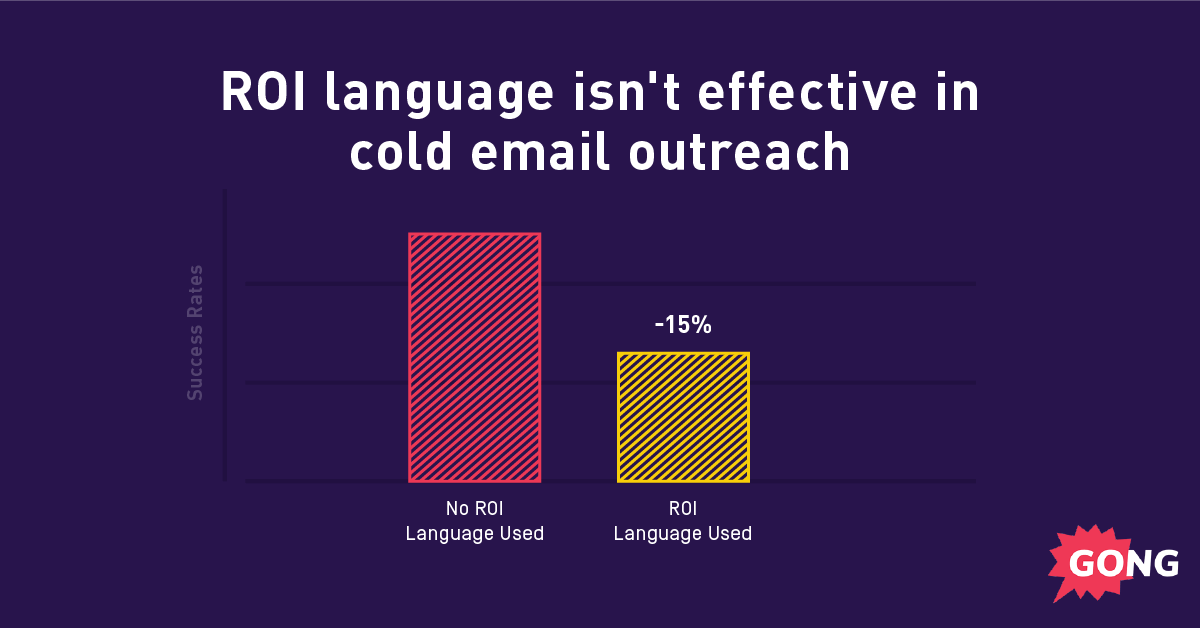Avoid this tempting cold email mistake at all costs
This article is part of the Gong Labs series, where I publish findings from our data research team. We analyze sales conversations and deals using AI, then share the results to help you increase revenue attainment. Follow me to read upcoming research.
He sighed, “Do they really expect me to respond to that?”
Thumbing through his inbox, I could see the agitation growing.
I had asked him how he responds to cold email promises like “increase global efficiency by 21%” when salespeople reached out to him.
“I don’t believe it, so I delete it.”
He’s a VP of Corporate Strategy at a 2,000-person tech company. His inbox is busier than the DMV on a Friday afternoon (you know, before the pandemic).
Cutting through the noise—even for just 3 seconds—is the name of the game.
But you and I know that’s easier said than done.
That conversation got me thinking… is using ROI in cold outreach a huge mistake?
Do decision makers roll their eyes and hit delete at the sight of lofty ROI promises?
To find out, the Gong Labs team analyzed 132,552 cold emails to uncover how ROI language affects your success rates.
And the answer might surprise you.
Sidebar: About this report
Before we dive into some eyebrow-raising insights, here’s a quick explanation of how we get our data at Gong Labs.
We analyze customers’ sales interactions captured by Gong’s Revenue Intelligence Platform, including web-conference meetings, phone calls, and emails. Then we look at how seller and buyer actions impact success rates.
For this report we analyzed 132,552 emails, specifically looking at how ROI language impacted cold email success rates.
We defined ROI language as the phrase “ROI” or any associated statistics (e.g., multipliers such as 2x, 2.5x, 30x, etc., and percentages such as 5%, 23%, or 33%, etc.) in the salesperson’s email.
We wanted to see what elicited a successful outcome, meaning a meeting booked in the next 10 days. Responses like “Remove me from your list” weren’t included in our analysis.
Now that you’re up to speed, here’s what you came for:
(PS: Want a list of money-making email tips? Download the 7 laws of highly effective sales emails.)
Stop using ROI language in cold emails
If you’re including ROI language in your cold emails, you’re making a HUGE mistake.
Using ROI language in cold emails decreases success rates by 15%.
Clearly, my VP friend’s frustration isn’t a one-off. This is a thing.
Bold promises about ROI don’t work.
Delete them from your sales template emails – STAT.
But what gives?
I mean, who can argue with ROI?
It’s hard facts and data!
Here’s why ROI doesn’t work for cold outbound
I get it—you want to tell prospects about the amazing results they’ll see with your solution. That’s why sending impressive numbers feels like the right thing to do. (I’ve done it too).
But when it comes to presenting ROI, there’s a difference between believability and effectiveness.
In other words, even if prospects believe your numbers are true, they won’t necessarily find them persuasive enough to book a meeting with you.
But why?
It falls flat because it starts with the end result without describing any context. What tangible problem does it solve?
And without that critical element, your ROI claims aren’t connected to the prospect’s reality. It’s just a stat.
It’s like telling someone about a movie but only sharing the final scene where the plot is resolved. There’s just no impact. The reader is left wondering, “So what? Why does it matter?”
Notice, I’m not saying NEVER use ROI language. I’m just saying it’s just mistimed in this cold email scenario.
To use it effectively, you need to tap into how the human brain is wired:
Buyer’s make decisions based on emotions, then justify their decision with logic (using facts, like ROI). More on this in our previous post.
You might be nodding right now but wondering, well then, what should I do?
6 more tips for booking meetings with email
Sales isn’t a slot machine, it’s a science.
So instead of throwing emails into the ether and “seeing what sticks,” boost your success rates by adding data to your approach today.
I pulled together the 7 Laws of Highly Effective Sales Emails to help you book more meetings with cold email, plus keep deals moving forward with razor sharp messaging.
Most of them are as simple as copy-paste-win.
It doesn’t get any easier than that.
Download the 7 Laws of Highly Effective Sales Emails.
Your future self (and your pipeline) will thank you.
Speaking of copy and paste… copy the link to this post and share it in your team’s Slack channel.
Your team will love you for it. Heck, they might even promote you (crazier things have happened this year).
And if you have any cold email tips of your own, share them in the comment section below.
PS: Can’t get enough data-backed sales tips? I’m presenting the next Gong Labs report live at Gong’s #celebrate event in October.
I’m going to share how to master rapport building in the era of virtual sales.
You can sign up here for free.
And if you’re on the fence, Chris Voss, author of Never Split the Difference is headlining.
So there’s that too.



